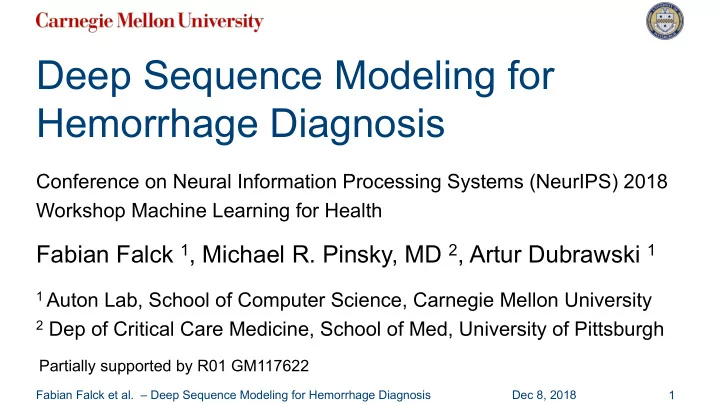

Deep Sequence Modeling for Hemorrhage Diagnosis Conference on Neural Information Processing Systems (NeurIPS) 2018 Workshop Machine Learning for Health Fabian Falck 1 , Michael R. Pinsky, MD 2 , Artur Dubrawski 1 1 Auton Lab, School of Computer Science, Carnegie Mellon University 2 Dep of Critical Care Medicine, School of Med, University of Pittsburgh Partially supported by R01 GM117622 Fabian Falck et al. – Deep Sequence Modeling for Hemorrhage Diagnosis Dec 8, 2018 1
Medical relevance and Task definition • Medical relevance: – Hemorrhage (internal bleeding) is the most common cause of trauma deaths and the most frequent complication of major surgery – With current medical practice , it is very difficult to identify until profound blood loss has already occurred due to interrelated reflexes of the body • Task: Predicting hemorrhage based on physiological reactions in waveform (250 Hz) vital sign without manual featurization Fabian Falck et al. – Deep Sequence Modeling for Hemorrhage Diagnosis Dec 8, 2018 2
Dataset Start of bleeding label • Controlled, constant blood loss on pred. 93 healthy pigs transitioning from stable to unstable [1] t=0min t=60min t=30min • Monitoring of 11 vital signs : – blood pressure (CVP, arterial pressure fluid filled and millar, pulmonary pressure) – oxygen saturations (SpO 2 , SvO 2 ) – EKG, Plethysmograph, CCO, stroke volume variation (Vigeleo), airway pressure • Chosen for experiments: 16 pigs bleeding at the slowest rate (5 mL/min) à hardest task [1] The study protocol was approved by the University of Pittsburgh IACUC Fabian Falck et al. – Deep Sequence Modeling for Hemorrhage Diagnosis Dec 8, 2018 3
Models and Experimental setup • Models: Gated Recurrent Unit (GRU) and dilated, causal convolution Gated Recurrent Unit (GRU) Dilated, causal convolution Inputs Outputs + Neural network layer x + with activation function f f f Convolutional filter + + x x 1- T ensor flow f f f f T ensor concatenation + + + + T ensor duplication f f f f f f f f x Pointwise multiplication + Pointwise addition 1- Pointwise operation • Experimental setup: – Training on randomly drawn time windows of length W (~20sec = 5000 dp.) – Subject-specific normalization (per vital sign), k=5-fold cross-validation Fabian Falck et al. – Deep Sequence Modeling for Hemorrhage Diagnosis Dec 8, 2018 4
Experimental results • GRU-based model achieves best performance in small false-positive range , while being inferior for negatives compared to a formidable baseline using manually extracted features and a random forest classifier Ours AUC (positives): 0.94 TPR@FPR=0.1%: 0.38 TNR@FNR=1%: 0.22 Baseline (RF + handcrafted features) AUC (positives): 0.97 TPR@FPR=0.1%: 0.15 TNR@FNR=1%: 0.64 Fabian Falck et al. – Deep Sequence Modeling for Hemorrhage Diagnosis Dec 8, 2018 5
Conclusion • Limitations: – 1) Potential biases due to lab draws and artefacts in the data might be root cause for inferior negative performance – 2) Raw predictions are noisy • Future work: – 1) Bayesian update scheme for raw classifier predictions – 2) Dilated, causal CNN as feature extraction head for subsequent RNN • … and for details, please come to my poster in session 2 ! Fabian Falck et al. – Deep Sequence Modeling for Hemorrhage Diagnosis Dec 8, 2018 6
Recommend
More recommend